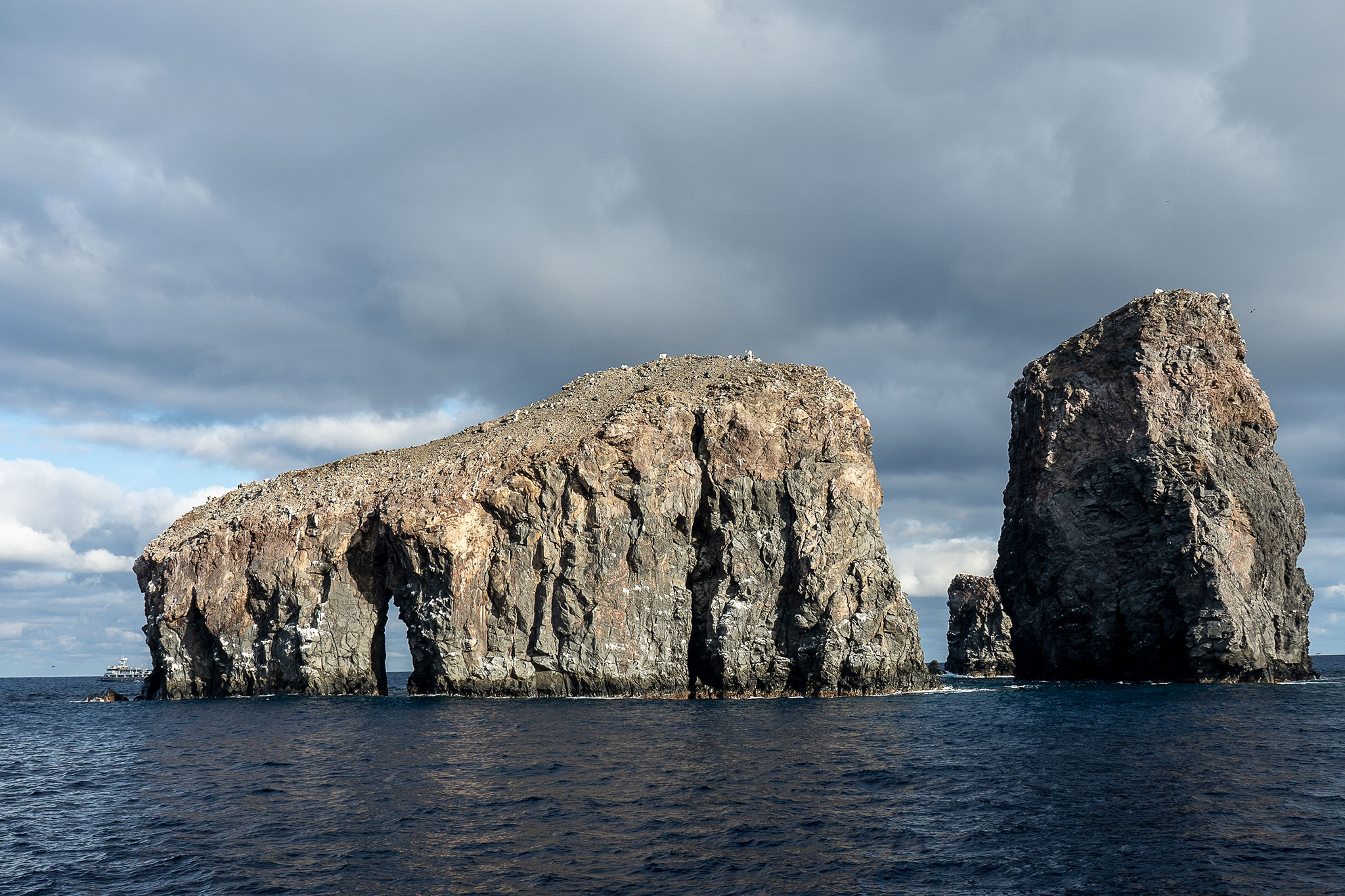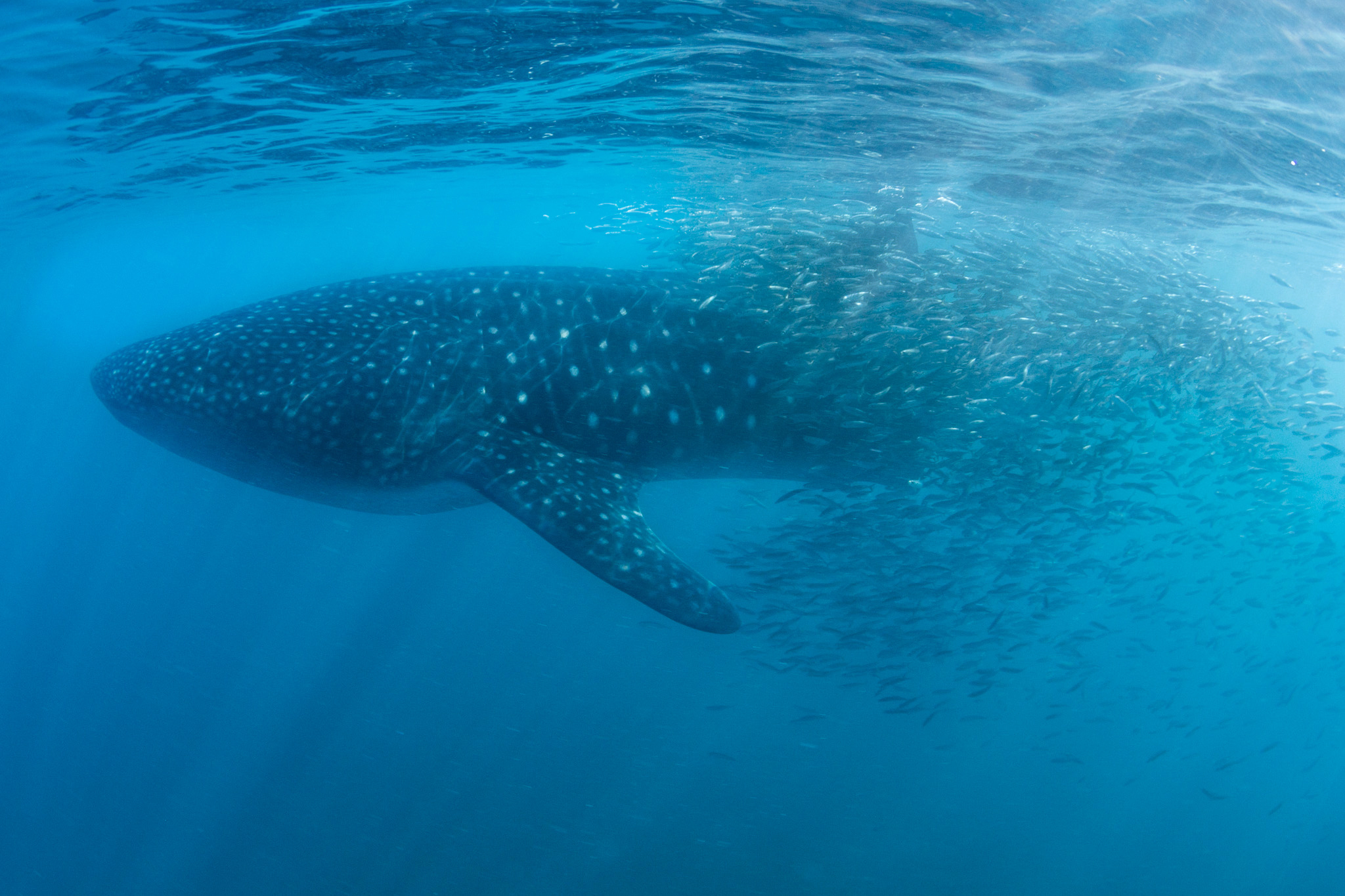Viewed above, it is possible to observe the footprint millions of years of geological history has left on the peninsula situated in the north of Mexico; the southern region is a rugged mass that stretches all across. We are talking about the sierras La Giganta and Guadalupe, an almost unexplored territory that starts (or ends, however the reader wishes to see it) in La Paz and stretches over 350 kilometers with a width that varies between 35 and 55 kilometers and encompasses four out of the five existing municipalities in Baja California Sur: La Paz, Comondú, Loreto and Mulegé.
The enormity of the mountain range makes it necessary to split it in three regions: north, center and south. It is obvious each region has its own trademarks and complexities, and those who study them have also defined zones and sub-zones because the sierra is home to deep canyons, extensive valleys, plateaus, peaks and coastal flatlands.
Sarahí Gómez, analyst at the Mexican Center for Environmental Law (Centro Mexicano de Derecho Ambiental, CEMDA), explains that the sierras are “territories environmentally, biologically, socially and economically important for the region. Within them, it is possible to find shrub forests, oases, seasonal ponds and oak forests, among other ecosystems, which are home to endemic species, many of them under the protection of environmental law”. Furthermore, the expert mentions that in the light of high-level global warming , we must be aware of the essential environmental services the sierras provide, such as the production of oxygen and the absorption of carbon dioxide.
La Giganta and Guadalupe keep many secrets. However, one secret has been revealed: “water is scarce in the entire region; it is a desertic zone”, tells us Sarahí but, she adds, “the sierras are responsible for providing water to the entire region”. How does this happen? Due to their peculiar orography and geology, rainfall or condensed water gathers on hillsides and then trickles down to form springs or lagoons or infiltrate aquifers and waterbeds that then emerge on the oases, those “green islands” that support date palms, pumas, hawks and, of course, ranchers. It is important to mention that without the vegetation layer on the sierras, rainfall or condensed water would simply trickle down to the sea, leaving behind a barren land.
In the book La Giganta and Guadalupe, with photos by Miguel Ángel de la Cueva and texts by Bruce Berger and Exequiel Ezcurra, the water phenomena is explained as follows: “the water comes the Sierra, and without this vein network, the region dies. All forms of life come the mountains as the mountains are the origin of water”. Therefore, the Sierra’s big secret is also a warning: the future and survival of Baja California Sur depends on the conservation of its mountain ranges.
No water, then nothing at all
The ecological importance of these mountains was pointed out in the Justification Study for the Declaration as Natural Protected Area of the Biosphere Reserve of La Giganta and Guadalupe, elaborated by the National Commission of Natural Protected Areas (CONANP, 2014): “the survival of the communities in and around the Sierras depends on the water that infiltrates and trickles down underground; this water is also the replenishment mechanism for the coastal aquifers”.
According to this study, 50% of the state’s communities depend on mountain water, communities such as: Santa Rosalía, Mulegé, Loreto, San Ignacio, La Purísima, San Isidro, San José de Comondú, San Miguel de Comondú, Ciudad Insurgentes, Ciudad Constitución, Las Pocitas and La Soledad, among others. The mountains also provide water for the Santo Domingo Valley, located in the Comondú municipality and where over 70% of the state’s agricultural output comes from.
Let us not forget the oases: there are 171 in total and Baja California Sur possesses 93% of the existing oases in the entire peninsula. Only 2 oases have a surface bigger than 2 km2; however, as the biologist Juan Hernández points out, “although the majority are small (some are even 50 meters), any source of water amidst the desert is crucial”.
The dwellers of the sierra
These mountains, as the rest of the peninsula, have not been thoroughly explored. There are canyons and peaks which biologists, or visitors, have not reached yet. “The entire peninsula is quite isolated”, says biologist Hernández; “in fact, many view the peninsula as an island because of the existence of so many endemic species”.
What we do know is that the Sierra is home to 64 mammal species, 12 of them endemic. The big horn sheep is the most representative, but let us not forget the mule deer, the Fennec fox or the wildcat. “Pumas have returned recently”, adds biologist Hernández, “this is a good indicator of the conservation state of the ecosystem”.
There are 199 bird species which live there, many of them endemic, like the Xantus humming bird or the pygmy owl and of course, the birds that arrive as part of their migration journey. Amphibians and reptiles? 37 species have been identified and it is precisely among this group where we find the most endemic species.
In terms of the flora, the assortment includes mesquites, ironwood, oaks and even a rare type of ambrosia that only grows in some of its plateaus. Also important are the date palms found in oases, although artificially introduced, their commercial value is key for the region. Lastly, there is the king of the desert: the cardon. It can be found all over the peninsula and it is the tallest cacti, it can grow up to 20 meters tall. Many of them are over 200 years old, their flowers feed insects and birds and “their fruits are edible, besides ranchers use them as wood to build roofs and fences”, explains Mr. Hernández.
However, there is so much more to learn. Take for example the case of bats, a key species for the ecosystem but, as the National Commission for the Understanding and Use of Biodiversity (CONABIO) points out, only a few studies have been undertaken to understand them better, despite the fact they are the second largest group of mammals in Baja California Sur. One important case is the long-nosed bat, which was at the brink of extinction in Mexico and the United States. After intense work, their populations recovered and since 2015, it has been taken off the list of endangered species in Mexico, although it continues to be under special protection. The long-nosed bat is an important pollinizer and seed disperser in the Sierra. Same as bats, how many other species urgently need to be studied? Discovered? Undoubtedly, the first step to do this is the protection of the sierras.
Guardians of secrets
Apart the fauna and flora of the sierras La Giganta and Guadalupe, the region also owns a historical and cultural heritage which includes cave paintings, petroglyphs, religious missions and of course the ranch culture, unique in the country and giver of identity to Baja California Sur.
The origins of the ranch culture go back to the xviii century, when the Spanish soldiers and the Jesuit missioners encountered the indigenous populations, cochimíes, guaycuras and pericues, resulting in the blend of two cultures which gave birth to a new society.
Foreigners contributed with agriculture (unknown by locals), stockbreeding and trades, and the locals contributed with traditional knowledge such as herbal medicine and water-rationing techniques. Since then, the ranchers are the keepers of distant secrets which have allowed them to survive in the inhospitable desert, and their isolation (to get to some ranches, it is necessary to travel three days on mule) has made them preserve their way of living exactly as it was centuries ago.
Regarding current human presence, it must be said that a key element to the good conservation of the region is that it is scarcely populated: the most recent census (2015) indicates that Baja California Sur is the least populated state in the country. Specifically, the Sierra’s population barely reaches 4,000 people; over 80% of them live in single-family ranches.
Yet, many areas have been disturbed and the entire sierra might be threatened, together with their culture which is living history. “The threats are well known”, mentions Sarahí Gómez, “the introduction of new species for stockbreeding, agriculture which displaces native species, illegal logging and poaching. In the end, biological issues affect the population of the region, which has managed to survive in this environment for centuries”.
The caves that speak
At least 10,000 years before the arrival of the colonizers to Baja California, nomad peoples used to roam the peninsula. The encounter with the Jesuits was their doom. However, they left traces of their presence: the collection of cave paintings and petroglyphs that exist in La Giganta and Guadalupe.
Only in Guadalupe, there are at least 800 known sites with traces of the cochimí culture. Possibly the most enigmatic cave paintings are those found in San Borjitas cave. María de la Luz Gutiérrez, an archeologist who has studied cave paintings in Baja California Sur for over 30 years, has cataloged 120 large motifs all over the San Borjitas cave. The researcher suspects these are the oldest “mural style” cave paintings, monumental paintings representing people, deities and fauna.
The paintings at San Borjitas might be as old as 7,500 years, which is long before the Aztecs developed their culture.
The importance of Sud Californian cave paintings located in the neighboring Sierra San Francisco led to them being declared UNESCO World Heritage in 1993. Undoubtedly, the declaration should be extended to La Giganta and Guadalupe, given their beauty and importance.
The great challenge
It has been made abundantly clear the cultural and ecological value of La Giganta and Guadalupe, but how to preserve them? The answer is simple, declare them Biosphere Reserve. The declaratory would not only protect their ecosystems, species, ranch culture and archaeological vestiges, but most importantly, it would protect the precious water.
Furthermore, the protected territory would be part of the other nine protected areas that exist in Baja California Sur, like the Vizcaino, north of the state and the largest one in the country. It would also be part of other conservation efforts such as the Conservation Plan for the Corridor San Cosme - Punta Mechudo, fostered by Niparajá Project since 2011 or the Units for the Conservation of Wildlife (uma), which have been instrumental for the rescue and responsible use of the bighorn sheep through regulated hunting schemes.
But what could possibly threaten such an isolated and scarcely populated region? The biologist Juan Hernández claims that, “opposite to what is generally believed, the desert is an extremely fragile ecosystem and it is easy to upset its balance. For the case of the sierras, there are disruptions around the populated areas and weather phenomena such as hurricanes have also hit the ecosystem, and recovery is slow”.
Undoubtedly, brushing aside the region’s ancient knowledge is having an effect. Most importantly, we are talking about water-rationing. Francisco Olmos, Executive Director for Niparajá, mentions the resource is in crisis: “the sierras provide water to the Valley of Santo Domingo which, according to data the National Water Commission (CONAGUA), it is the aquifer with the largest deficit in the state (around 40 million cubic meters). This means that the amount of water extracted is larger than what it manages to replenish. And this is getting worse each year”. Modern times have brought with them the construction of tourist and housing developments, unfortunately with no adequate planning. Other problems are caused by roads that cut off natural corridors, poaching, illegal logging and the presence of alien flora and fauna. The introduction of goats has become a nightmare for the entire peninsula, including the islands. Other species that have been artificially introduced are tilapia, pigs and even donkeys, — the last two species become feral—, or the Virgin Mantle plant, which invades oases and consumes all the water.
And there is of course the temptation of mining, which is highly damaging for the environment and roams the sierras: up until now 16 concessions have been granted but none has started operating yet. The rancher culture is also under enormous pressure: “according to the National Institute of Geography and Statistics (INEGI), 700 to 1,000 people leave the sierra each year”, explains Francisco Olmos; “it is expected that by 2,040 only the elders will remain in the rural communities”. According to the expert this is due to the high level of deprivation in the area.
Land ownership is another problem, in many cases ranchers do not have property titles or, as Francisco Olmos mentions, “even if they do, when they migrate and abandon their property, developers take over it to build hotels”. In addition to this, globalization has brought in external products, devaluing local products and crafts creating a “social void”, as the expert mentions and with this comes the loss of part of the national history.
Mario Sánchez, Northwest Regional Director for the Mexican Center for Environmental Law (CEMDA), mentions it is easy to understand the concept of Natural Protected Area if we think about it as environmental stock: “imagine you have a warehouse and to operate it you need a reserve of water, oxygen, animals or forests that we can use”.
However, the expert mentions that the concept of Natural Protected Area is commonly misinterpreted: “people think it is about expropriating land, but it is not the case; the point is to set healthy limits that even benefit those who live in the protected area. In fact, the population is always taken into account. Juan Hernández gives an example: “Baja California has always had stock breeders, ranchers raise goats and cows, is the declaration as a natural protected area about imposing a ban on their livelihoods and traditions? No, the idea is to teach them how do it responsibly.” The biologist believes there are productive activities which have a positive effect and generate income for the communities.
As Francisco Olmos told us, before thinking about the Biosphere Reserve status, conservationists are already working with ranchers on productive projects, therefore the declaratory “would only complement the actions that have already started.”
Considering all the above, the creation of the Biosphere Reserve at Sierras La Giganta and Guadalupe would bestow a legal framework, which is the first step to resolve the current issues and afterwards, assure that the entire area will be preserved for future generations of Mexicans.
The threat of carbon
Traditionally, mesquite has been very important for ranch culture: houses, fences and pens are built out of this wood. However, ranchers have discovered another use, you can obtain excellent carbon mesquite. The problem is that carbon can only be obtained older specimens, which is decimating the species. Because young specimens are not usable for this activity, the species is still viable. Ironwood trees are also used for carbon: “it has export quality”, mentions expert Sarahí Gómez. Same as mesquite, it is being overexploited and older specimens, some millenary, are being lost, and with them, the natural history of the sierra which has been kept in their rings.
Which is the solution? “Regulated logging to avoid over-exploitation, while still offering an economic alternative for ranchers”. The use of solar pots and Patsari cookers, both eco-friendly technologies, will also decrease the carbon footprint of homes in the Sierra.
A valuable resource to consider
Could tourism potentially be beneficial for the conservation of the Sierras? “Yes, as long as it is low impact”, the CEMDA expert told us. Nature tourism, camping and mule rides could be economically beneficial for the ranchers and the small communities at the sierras. Currently, tourism is practically nonexistent, but experience proves it is possible to develop it: there are small expeditions to visit the cave paintings or the missions. The same occurs with the oases and hunting tourism has shown potential. The challenge? Benefit the Sierra communities.
The symbol of Mexico
One of the dwellers of these mountains is the golden eagle (Aquila chrysaetos). Yes, the majestic predatory bird which is on our national emblem, lives in the Sierra under special protection. This bird acts as regulator for the ecosystem as it controls the population of hares, rabbits and insects. The actions taken for its preservation have been successful. There were 70 couples accounted for nationwide in 2010. Records for 2019 show the number went to 159. For the case of Baja California, they are found at the Biosphere Reserve Sierra La Laguna, but can also be seen at La Giganta and Guadalupe.











